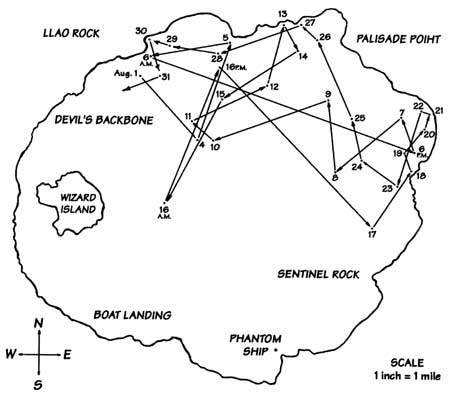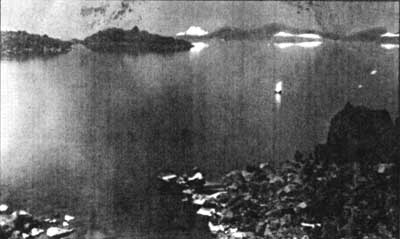The Old Man of the Lake
On the calmest of days and with a bit of luck, one might be able to see a boat on Crater Lake or even a floating weather station from the rim. The sharpest eyes may catch a glimpse of something very peculiar on the lake surface, what appears as a very small and whitish dot. Like other objects seen from a distance, however, its size from the rim belies how large it actually is. This untethered voyager has been observed even before the lake became part of a national park and seems to be as unchanging as Wizard Island or Phantom Ship. For just as long this denizen of the deep blue has been called the Old Man of the Lake.
Many, if not all, lakes contain floating and sunken woody material. Few lakes, though, have a large conifer floating in a vertical position which appears to be rooted to the bottom of the lake wherever it is seen. The Old Man is about 30 feet long and has a diameter of roughly two feet at waterline. Its top stands approximately four feet out of water and is bleached white. The exposed end is splintered but buoyant and wide enough to support a person’s weight.

 Map showing the Old Man’s movements, August 1938, by John E. Doerr.
Map showing the Old Man’s movements, August 1938, by John E. Doerr.
The Old Man poses a few questions which have been asked continually by park employees and visitors alike. One concerns his age. Joseph S. Diller published the first geology of Crater Lake in 1902, the same year that this area became a national park. In his work, a short paragraph describes a great stump he found six years earlier to be rooted below the lake’s surface on the west shore of Wizard Island. Diller wrote that if a tree once grew in this location, the lake must have been much lower in recent times. He did not, however, hypothesize about the tree in question being the Old Man. Instead, Diller stated that trees commonly slide into Crater Lake, roots first. This was attributed to the caldera’s steep slopes, but how is it that only one log floats vertically in Crater Lake? There may be a specific set of circumstances which give rise to this phenomena. The Old Man presently meets all of the criteria. Perhaps this is similar to the occurrence of life in this universe — it just happens to fit the criteria!
In 1896, the Old Man floated just as it does at present. This, of course, prompts the question of how a log can float in such a position. Some have suggested that when the Old Man slipped into the lake, he had rocks bound within his roots. This might naturally make him float vertically, though no rocks appear to still be there. At any rate, the submerged end could become heavier over time through being waterlogged. Acting like the wick on a candle, the shorter upper portion of the Old Man remains dry and light. This apparent equilibrium allows the log to be very stable in the water.
Diller established that the Old Man could travel by tying bailing wire around the log and pulling it a short distance in 1896. Five years later Diller observed the Old Man to be a quarter mile from where he previously noted its location. This should not imply, however, that the log is slow-moving and confined to one part of the lake. An article which appeared in the 1938 volume of Nature Notes from Crater Lake documented that the Old Man rides the winds and currents to travel the lake’s entire surface area and can cover almost four miles in a single day.
Just as the verdure of the trees surrounding Crater Lake provide a sharp contrast to the deep blue water, green moss on the Old Man produces the same effect below the waterline for those fortunate enough to see this log at close range. In addition to the luxuriant growth of moss below the surface, there are spiders and ants above the water. Although limited in its diversity, this thriving community of life is just one of the ways that the Old Man commands attention.

Old Man near Wizard Island. Photo by J.S. Diller, 1901.
Since he can be seen virtually anywhere on Crater Lake, boat pilots commonly communicate his position to each other as a matter of safety. At two feet across and four feet high, the Old Man would not be someone to meet when traveling by boat across the lake. During the submarine explorations in 1988, scientists agreed to the idea of tying up the Old Man off the eastern side of Wizard Island. They reasoned that this navigational hazard had to be neutralized until the day and night shifts of research work had ended. Strangely enough, the weather went from clear to stormy and even scientists get nervous when this occurs on the lake. It seemed as if the weather was poor so long as the Old Man remained bound. Once the log was freed, however, the weather settled.
In more than one article about the Old Man, writers have expressed doubt as to whether he will persist through the stormy blasts of winter weather on Crater Lake. It now appears that mortals should worry about something else, because the Old Man has shown he knows this lake and can take care of himself. A better question might be will you be back to see the Old Man?
John Salinas teaches science at Rogue Community College in Grants Pass, Oregon, and has worked as a limnologist and seasonal naturalist at Crater Lake.

